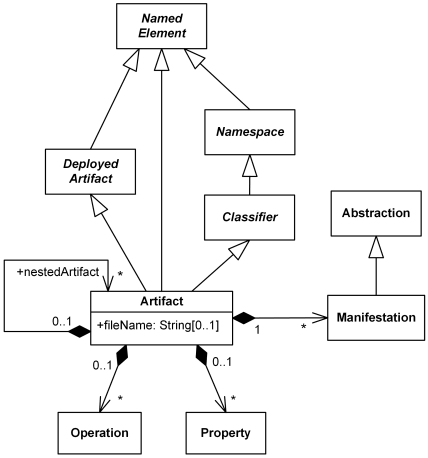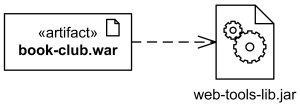UML Artifact
An artifact is a classifier that represents some physical entity, a piece of information that is used or is produced by a software development process, or by deployment and operation of a system. Artifact is a source of a deployment to a node. A particular instance (or “copy”) of an artifact is deployed to a node instance.
Some real life examples of UML artifacts are:
- text document
- source file
- script
- binary executable file
- archive file
- database table
The UML Standard Profile defines several standard stereotypes that apply to artifacts:
| «file» | A physical file in the context of the system developed. |
|---|---|
Standard stereotypes - subclasses of «file»:
| «document» | A generic file that is not a «source» file or «executable». |
|---|---|
| «source» | A source file that can be compiled into an executable file. |
| «library» | A static or dynamic library file. |
| «executable» | A program file that can be executed on a computer system. |
| «script» | A script file that can be interpreted by a computer system. |
Standard UML 1.x stereotype that is now obsolete:
| «table» | Table in database. |
|---|---|
Standard stereotypes can be further specialized into implementation and platform specific stereotypes in profiles. For example, Java profile might define «jar» as a subclass of «executable» for executable Java archives. Specific profiles are expected to provide some stereotype for artifact representing sets of files.
UML specifications define artifact as a subclass of abstract deployed artifact. Deployed artifact is described as an artifact or artifact instance that has been deployed to a deployment target. Common sense says that the relationship has to be reversed - deployed artifact should be a subclass of artifact, while it has to be allowed for some artifacts not to be deployed at all.
UML abstract syntax of Artifact.
Artifacts may have properties that represent features of the artifact, and operations that can be performed on its instances. Artifacts have fileName attribute - a concrete name that is used to refer to the artifact in a physical context - e.g. file name or URI. Artifact could have nested artifacts.
Artifacts are deployed to a deployment target. Instance specification was extended in UML to allow instances of artifacts to be deployed artifacts in a deployment relationship.
An artifact is presented using an ordinary class rectangle with the keyword «artifact». Examples in UML specification also show document icon in upper right corner.
Artifact web-app.war
C# source file artifact UserServices.cs
Library commons.dll
Alternatively, artifact may be depicted by an icon.
Artifact web-tools-lib.jar
Optionally, the underlining of the name of an artifact instance may be omitted, as the context is assumed to be known to users.
Associations between Artifacts
Artifacts can be involved in associations to other artifacts, e.g. composition associations. For instance, a deployment descriptor artifact for a component may be contained within the artifact that manifests that component. In that way, the component and its descriptor are deployed to a node instance as one artifact instance.
Application book-club.ear artifact contains EJB user-service.jar artifact and deployment descriptor.
Dependency between Artifacts
Artifacts can be involved in dependency relationship with other artifacts.
Dependency between artifacts is notated in the same way as general dependency, i.e. as a general dashed line with an open arrow head directed from client artifact to supplier artifact.
The book-club.war artifact depends on web-tools-lib.jar artifact. Manifestation
Manifestation

